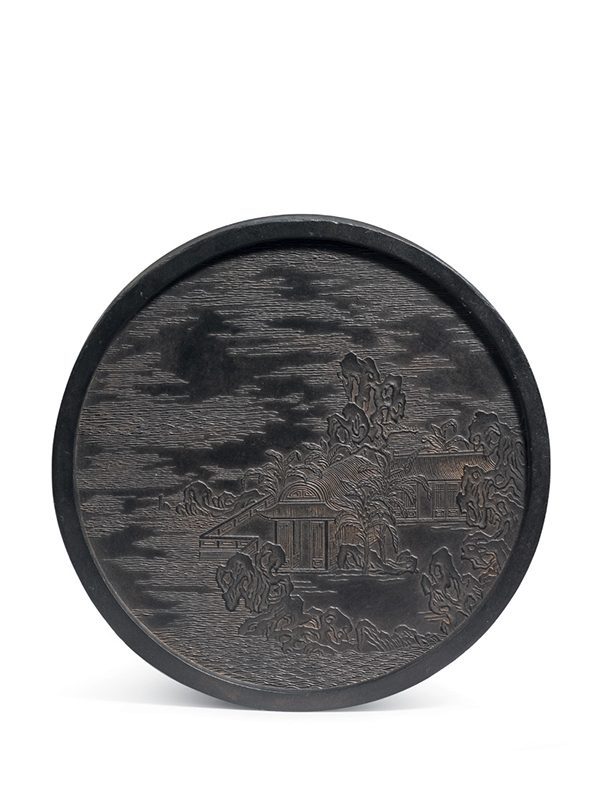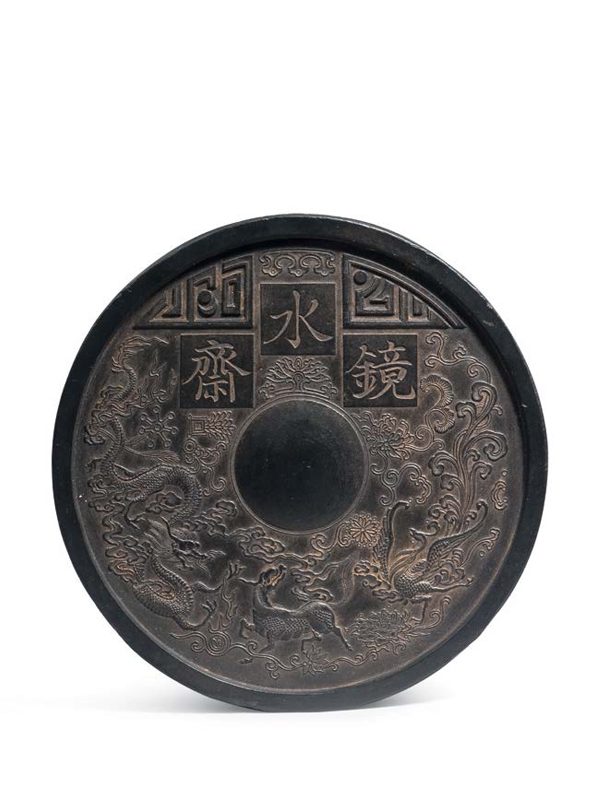Ink cake of circular form
A circular ink cake with a landscape and with animal patterns to the reverse. The reverse has a circle raised in the middle, with a three-character inscription reading Jing Shui Zhai on the top and a coiled dragon, a qilin and a phoenix among the clouds to the lower part. The other side is moulded with a landscape scene, with a pavilion amongst rugged rocks, together surrounded by wavy water. The side of the ink cake is moulded with four characters, reading Jia qing nian zhi (Made during the Jiaqing reign).
This delicately made ink cake is a rare example produced during the reign of the Jiaqing Emperor (1796 – 1820), the son of the Qianlong Emperor. The three-character inscription Jing Shui Zhai, literally meaning ‘Mirror-Water Hall’, refers to one of the buildings in the Old Summer Palace, Yuanming Yuan. This piece forms part of the 64 ink sticks set known as Yu Yuan Tu (Images of the imperial buildings), each depicting different buildings in the Palace and Yuanming Yuan. The design of this ink cake imitates an archaic bronze mirror, which has a knob in the middle, after its name ‘Mirror’. The earliest examples of ink are found in traces of writing dating to the fourteenth century BC. The ink used by the calligrapher was water- based and prepared in stick or cake form. Ink was principally made from carbon obtained from burning resinous pinewood, to which lampblack made from animal, vegetable or mineral oils was added. This was mixed with glue, moulded into a cake and dried.[1] Three comparable circular ink cakes, respectively decorated with a thousand-year fungus motif, a design of two phoenixes and a design of five pines, all dated to the late Qing to the early Republic period, are in the collection of the Metropolitan Museum of Art.[2] Two further examples, both similar with the design of the ‘One hundred sons’, are respectively in the collection of the British Museum[3] and the Metropolitan Museum of Art.[4] A complete set of Yu Yan Tu ink sticks is in the collection of the Palace Museum, Beijing.[5]
- Rawson, J. The British Museum book of Chinese Art, British Museum, London, 1992, pp. 87-88
- The Metropolitan Museum of Art online collection archive, accession number: 30.76.196, 30.76.199 & 30.76.203
- Rawson, J. op. cit. fig. 53, p. 87; also see the British Museum online collection archive, museum number 1909,0611.5. This piece is dated to the Ming dynasty.
- The Metropolitan Museum of Art online collection archive, accession number: 30.76.280. This piece is dated to the late Qing to early Republic period instead.
- Lin, Huan, ‘Mo Shang de Fan Hu Jiu Mong- Hu Kai Wen yu Ji Jing Mo (The Splendors Past on the Ink- Hu Kai Wen and Ink Sticks Set ’ in Forbidden City, Palace Museum, Beijing, 2012, vol. 8, pp. 108-119
「鏡水齋」圓形墨錠
清 嘉慶 1796 – 1820 徑:11.8 公分 厚:1.8 公分
圓形墨錠,正面中央突起一圓鈕,上半部從右至左書「鏡水齋」三字楷書款,下半部模印出降
龍、朱雀與麒麟,周身祥雲漫溢。背面模印屋宇樓閣襯於山光浮雲之間。墨錠側緣凸印「嘉慶年
製」四字楷書款。此墨錠原應為「御園圖集錦墨」一套六十四錠之其中一錠。集錦墨是由多錠墨
組合成一整套墨,發端於明代嘉靖年間。「御園圖集錦墨」選材於當時北京大內(紫禁城)、西
苑(中南海、北海)和圓明園三園(圓明園、長春園、萬春園)。其中保存二十九處圓明園景觀
墨圖,全部依照乾隆末年至嘉慶初年圓明園的實景雕刻而成,為後人打開圓明園秀麗風景的一扇
窗口,「鏡水齋」即為圓明園建築之一。北京故宮博物院藏有一整套嘉慶年款「御園圖集錦墨」
,可資比較。


